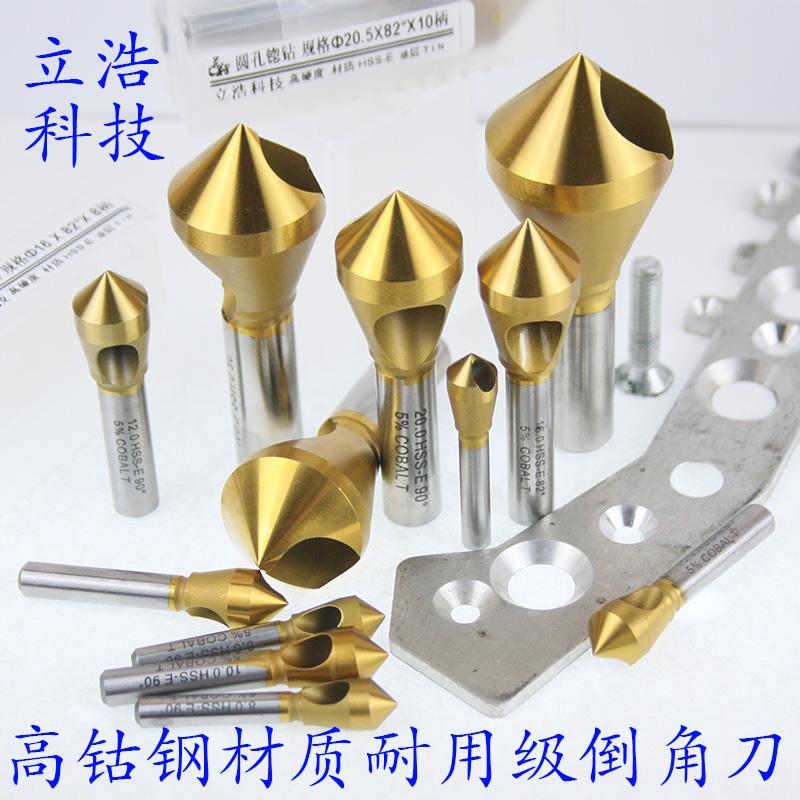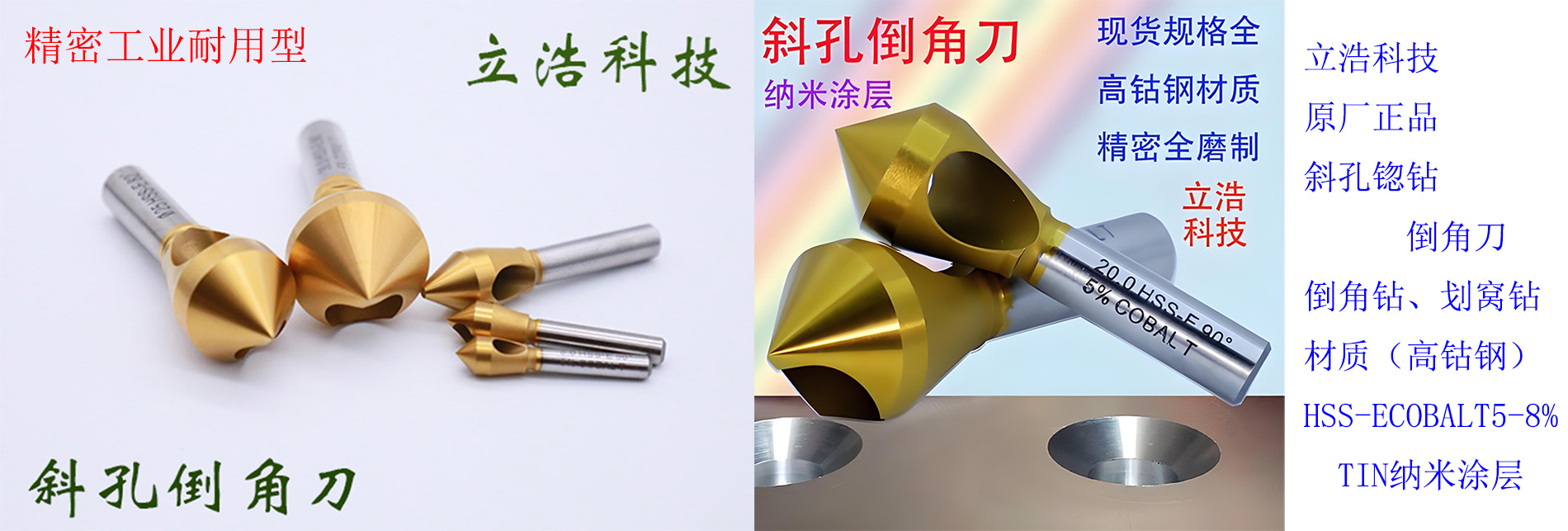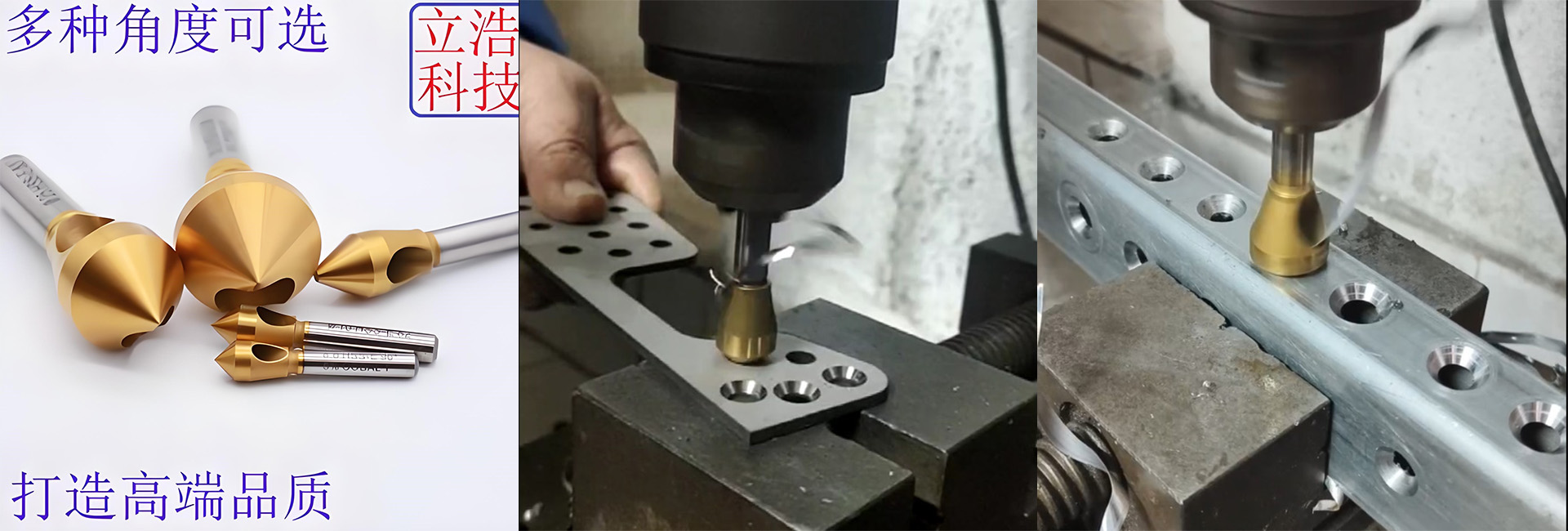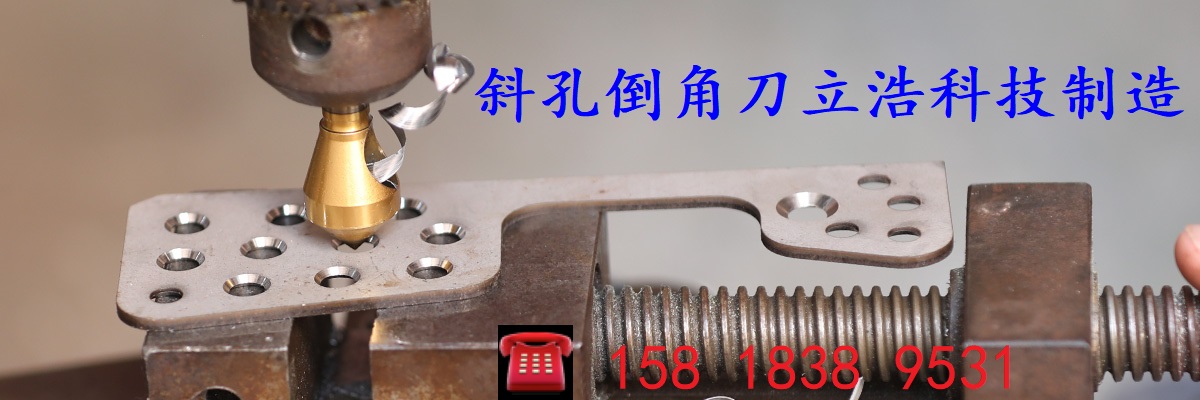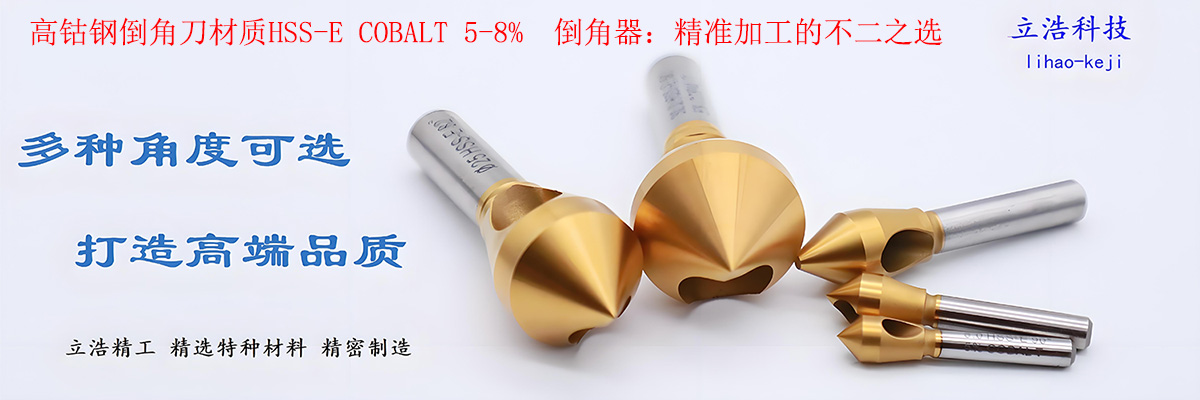Definition and Function
A chamfer tool, also known as a countersink, is a specialized cutting tool used in machining processes. Its primary function is to create a beveled edge or chamfer on the edges of a workpiece, typically at the entrance or exit of a hole. This process not only removes sharp edges and burrs but also improves the overall appearance and functionality of the part.
In mechanical processing, the use of a chamfer tool serves several crucial purposes. First and foremost, it enhances the safety of the final product. Sharp edges on machined parts can pose a risk to operators during handling and assembly, as well as to end - users. By creating a smooth, beveled edge, the chamfer tool eliminates these sharp corners, reducing the likelihood of cuts or injuries.
Secondly, chamfering plays a significant role in the assembly process. When two parts are joined together, a chamfered edge can help guide the components into place more easily, reducing the chances of misalignment. This is especially important in high - precision industries such as aerospace and automotive manufacturing, where even the slightest misalignment can lead to performance issues or component failure. For example, in the assembly of engine components, chamfered edges on bolts and holes ensure a smooth fit, allowing for proper torque application and preventing leaks.
Moreover, chamfering can improve the structural integrity of a workpiece. Sharp edges can act as stress concentrators, which may lead to cracks or fractures under stress. By removing these sharp edges, the chamfer tool distributes stress more evenly across the surface of the part, increasing its fatigue resistance and overall durability.
In addition to these functional benefits, chamfering also contributes to the aesthetic appeal of the final product. A well - chamfered edge gives a finished, professional look to the workpiece, which is important in industries where appearance matters, such as consumer electronics and jewelry manufacturing.
Types of Chamfer Tools
There is a diverse range of chamfer tools available, each designed with specific features to meet different machining requirements. Here are some of the most common types:
1. Flat - bottomed Countersinks (Flat - bottomed Drills)
Flat - bottomed countersinks, also known as counterbores, are characterized by their cylindrical shape with a flat - ended cutting edge. They typically have 3 - 4 teeth on both the circumference and the end face. A key feature of flat - bottomed countersinks is the presence of a detachable guide post. When inserted into a pre - drilled hole, this guide post ensures that the new hole being created is concentric with the original one, minimizing coaxiality errors. For example, in the assembly of mechanical components where precise alignment of holes is crucial, such as in engine blocks, flat - bottomed countersinks are used to create accurate recesses for bolts or screws. These recesses allow the bolt heads or screw heads to sit flush with the surface, providing a smooth and stable connection.
2. Conical Countersinks (Conical Drills)
Conical countersinks have a conical cutting edge. The cone angle (2φ) can vary according to the requirements of the workpiece, with common angles including 60°, 75°, 90°, and 120°, among which the 90° cone angle is the most frequently used. This type of chamfer tool is mainly used for creating conical - shaped holes, such as those for countersunk screws. The conical shape of the hole allows the screw head to be recessed into the workpiece, providing a flush - fitting surface. In the manufacturing of furniture, especially in high - end pieces where aesthetics and functionality are both important, conical countersinks are used to create clean - looking screw - fixing points. The smooth, angled edges created by the conical countersink not only enhance the appearance but also prevent snagging on other objects.
3. Face - milling Countersinks (Face - milling Drills)
Face - milling countersinks are designed specifically for machining the end faces of holes. They can ensure that the end face of the hole is perpendicular to the hole's central axis. When the diameter of the pre - drilled hole is small, to maintain the strength of the tool shank, a section of the shank's diameter is designed to have a clearance fit with the pre - drilled hole, providing good guidance during the machining process. In the production of hydraulic components, where the flatness and perpendicularity of hole end - faces are critical for sealing and proper functionality, face - milling countersinks are used to achieve the required precision. These components often need to withstand high - pressure fluids, and any deviation in the hole end - face can lead to leakage or component failure.
4. Single - edge Chamfer Tools
Single - edge chamfer tools are relatively simple in structure, with only one cutting edge. They are highly versatile and can be used for chamfering, beveling, and grooving operations on various materials. However, their processing speed is relatively slow compared to multi - edge tools, and they are more prone to wear. For example, in small - scale metalworking shops or in the repair of precision instruments, single - edge chamfer tools may be used for delicate operations where high - precision and fine - tuning are required.
5. Double - edge Chamfer Tools
Double - edge chamfer tools have two cutting edges, which allows them to perform chamfering operations on both the upper and lower surfaces simultaneously. This significantly increases the processing speed and efficiency. In mass - production industries such as automotive manufacturing, where large - scale production of parts with chamfered edges is required, double - edge chamfer tools are often used to meet the high - volume production demands while maintaining a certain level of quality.
6. Multi - edge Chamfer Tools (such as Four - edge or Six - edge Tools)
Multi - edge chamfer tools, with more than two cutting edges, are designed for processing larger - diameter holes. They offer greater cutting stability and can remove material more efficiently. Their large cutting depth capacity makes them suitable for heavy - duty machining tasks. For instance, in the construction machinery industry, when machining large - sized components like engine housings or chassis parts, multi - edge chamfer tools can quickly and accurately create the required chamfered edges, contributing to the overall strength and functionality of the final product.
Working Principle
The working principle of a chamfer tool is based on the fundamental concepts of cutting and material removal in machining processes. At its core, a chamfer tool operates through a combination of rotational motion and axial feed.
When in operation, the chamfer tool is typically mounted on a spindle of a machining device, such as a drill press, milling machine, or CNC (Computer Numerical Control) machine. The spindle rotates the chamfer tool at a high speed. This rotational motion provides the necessary cutting force. The cutting edges of the chamfer tool, which are designed with specific geometries depending on the type of chamfer tool (as mentioned in the types section), come into contact with the workpiece.
As the tool rotates, the sharp cutting edges engage with the material of the workpiece. For example, in the case of a conical countersink, the conical cutting edge gradually cuts into the workpiece material at the edge of the hole or the surface where the chamfer is to be created. The material is then sheared off in small chips, which are removed from the cutting area.
Simultaneously, the tool is fed axially towards the workpiece. This axial feed determines the depth of the chamfer. By precisely controlling the rotational speed of the tool and the rate of axial feed, machinists can achieve the desired chamfer angle, depth, and surface finish.
In the case of multi - edge chamfer tools, each cutting edge contributes to the material removal process. The multiple edges work in unison, with each edge taking turns to cut a small amount of material. This distributed cutting action not only increases the efficiency of the machining process but also helps in maintaining a more consistent and smooth chamfer surface. For instance, in a four - edge chamfer tool, as the tool rotates, each of the four edges makes a pass over the workpiece surface, gradually removing material to create the chamfer.
The design of the cutting edges also plays a crucial role in the working principle. The edges are often ground to have a specific rake angle and clearance angle. The rake angle determines the direction of the cutting force and the ease with which the tool can penetrate the workpiece material. A positive rake angle can reduce the cutting force required, making the machining process more energy - efficient, especially when working with softer materials. The clearance angle, on the other hand, prevents the back of the cutting edge from rubbing against the newly formed chamfer surface, which could cause damage to the surface finish and increase the cutting force.
In summary, the working principle of a chamfer tool is a harmonious combination of high - speed rotation, precise axial feed, and well - designed cutting edges. This allows the tool to accurately and efficiently create chamfers on workpieces, meeting the diverse requirements of modern manufacturing processes.
Selection and Usage
Selection of Chamfer Tools
Selecting the right chamfer tool is crucial for achieving optimal machining results. Here are some key factors to consider:
Workpiece Material: Different materials have distinct properties, and the choice of chamfer tool needs to be tailored accordingly. For instance, when working with soft materials like aluminum or copper, a chamfer tool with a relatively larger cutting edge angle (such as a 45 - degree angle) can be used. The larger angle allows for a more efficient removal of material without causing excessive deformation of the soft workpiece. On the other hand, when machining hard materials like hardened steel or titanium, a smaller cutting edge angle (e.g., 30 degrees or less) is often preferred. This is because the smaller angle concentrates the cutting force, enabling the tool to penetrate the hard material more effectively while maintaining the integrity of the cutting edge.
Workpiece Shape: The shape of the workpiece also plays a significant role in tool selection. For small - sized workpieces with intricate geometries, a chamfer tool with a small diameter and a fine - tuned cutting edge is required. This ensures that the tool can reach and chamfer the edges accurately without causing damage to the surrounding areas. In contrast, for large - scale workpieces, a chamfer tool with a larger diameter and higher material - removal capacity is more suitable. It can cover a larger area in a single pass, improving the overall machining efficiency. For example, in the production of large - scale steel structures, large - diameter multi - edge chamfer tools are often used to chamfer the edges of the steel plates quickly.
Chamfer Angle and Radius Requirements: The desired chamfer angle and radius are determined by the design specifications of the workpiece. If a smooth and rounded chamfer is required, a chamfer tool with a larger radius should be selected. This type of tool creates a more gradual transition at the edge, which is often aesthetically pleasing and can also improve the stress - distribution characteristics of the part. For applications where a sharp - angled chamfer is needed, such as in some precision - fitting components, a tool with a smaller radius and a well - defined angle is the better choice.
Machining Equipment Compatibility: The chamfer tool must be compatible with the machining equipment being used. This includes ensuring that the 刀柄 of the chamfer tool fits properly into the spindle of the machine. For example, in a milling machine, the taper of the chamfer tool's shank should match the taper of the milling machine's spindle. Additionally, the power and speed capabilities of the machine should be considered. If the machine has a low - power spindle, a chamfer tool with a smaller diameter and lower material - removal rate may be more appropriate to avoid overloading the machine.
Usage of Chamfer Tools
Proper usage of chamfer tools is essential for achieving high - quality chamfering and ensuring the longevity of the tool. Here are the correct installation and operation methods:
Cleaning: Before installation, thoroughly clean the 刀柄 of the chamfer tool and the clamping device on the machine. Any dirt, debris, or oil residue can affect the accuracy of the tool's installation and its performance during machining. Use a clean cloth or a specialized cleaning agent to remove all contaminants.
Tightening: Use the appropriate tool (such as a wrench) to tighten the clamping mechanism securely. Ensure that the tool is held firmly in place to prevent any movement during machining. However, avoid over - tightening, as this can damage the tool or the clamping device.
Cutting Speed Control: The cutting speed is a critical parameter that affects both the quality of the chamfer and the lifespan of the tool. A general rule of thumb is that for harder materials, the cutting speed should be lower. For example, when chamfering hardened steel, the cutting speed may be set at around 20 - 50 meters per minute. In contrast, when working with softer materials like aluminum, the cutting speed can be increased to 100 - 300 meters per minute. If the cutting speed is too high, the tool may overheat, leading to rapid wear of the cutting edges and a poor - quality chamfer. Conversely, if the cutting speed is too low, the machining process will be inefficient, and the surface finish of the chamfer may be affected.
Cutting Depth Control: The cutting depth should be adjusted according to the material and the desired chamfer size. It is advisable to start with a small cutting depth and gradually increase it in small increments. For example, in the initial pass, the cutting depth can be set to 0.1 - 0.2 mm. As the machining progresses and the stability of the process is verified, the cutting depth can be increased to 0.5 - 1 mm, depending on the material and the tool's capabilities. A large cutting depth in a single pass can put excessive stress on the tool, causing it to break or wear out prematurely. Additionally, it can also lead to inaccurate chamfering and surface roughness.
Coolant Application: Using an appropriate coolant during the chamfering process is highly recommended. Coolants serve multiple purposes. Firstly, they help to reduce the temperature generated during cutting, which can prevent the tool from overheating and improve its lifespan. Secondly, coolants can also act as lubricants, reducing the friction between the tool and the workpiece. This results in a smoother cutting action, better surface finish, and reduced cutting forces. For example, in high - speed machining of steel, a water - based coolant with anti - corrosion and lubricating additives can be used. The coolant should be applied directly to the cutting area, either through a nozzle on the machine or by using a mist - spraying system.
Maintenance and Troubleshooting
Maintenance of Chamfer Tools
Proper maintenance of chamfer tools is essential for ensuring their longevity and continued performance. Here are some key maintenance practices:
Regular Cleaning: After each use, it is crucial to clean the chamfer tool thoroughly. Use a soft - bristled brush or a clean cloth to remove any chips, debris, or coolant residue from the tool's surface and cutting edges. Chips can accumulate in the flutes of the tool, which may cause clogging and affect the cutting performance. Coolant residue, especially if it contains corrosive substances, can lead to rusting and corrosion of the tool. For example, in a metal - machining workshop where steel workpieces are being chamfered, iron chips can stick to the chamfer tool, and if not removed, they can cause abrasion on the tool surface during the next use.
Inspection of Cutting Edge Wear: Regularly inspect the cutting edges of the chamfer tool for signs of wear. This can be done visually or with the help of a magnifying glass. Look for any dullness, nicks, or chipping on the edges. A worn - out cutting edge will not only reduce the quality of the chamfer but also increase the cutting force required, which may lead to tool breakage or damage to the workpiece. For instance, in a high - precision machining process for aerospace components, even a slight wear on the chamfer tool's cutting edge can result in a non - compliant part.
Lubrication and Rust Prevention: Apply a suitable lubricant or rust - preventive oil to the tool. This helps to reduce friction between the moving parts of the tool (if applicable) and also protects the tool from rust and corrosion. Before applying the oil, make sure the tool is clean and dry. For example, in a humid workshop environment, a thin coat of rust - preventive oil can significantly extend the lifespan of the chamfer tool. Store the tool in a dry place when not in use, preferably in a toolbox or a storage rack designed to keep tools organized and protected.
Troubleshooting Common Issues
Despite proper maintenance, chamfer tools may encounter some common problems during operation. Here are some of these issues and their corresponding solutions:
Cause: Excessive cutting speed, improper cutting parameters, or machining of hard and abrasive materials can cause rapid tool wear. For example, if the cutting speed is set too high when chamfering hardened steel, the tool's cutting edges will experience high - temperature and high - stress conditions, leading to accelerated wear.
Solution: Adjust the cutting parameters according to the workpiece material. Reduce the cutting speed for harder materials and increase the feed rate slightly to maintain an efficient machining process. Additionally, choose a chamfer tool with a more suitable material for the workpiece. For example, if machining a very hard alloy, a carbide - tipped chamfer tool may be a better choice than a high - speed steel tool.
Cause: This can be due to a variety of factors. An unbalanced or poorly installed tool can cause vibrations during cutting, resulting in a rough surface. Dull cutting edges also contribute to poor cutting quality. In addition, incorrect coolant application or a lack of coolant can lead to overheating of the tool and workpiece, affecting the surface finish.
Solution: First, check the installation of the tool to ensure it is properly balanced and securely fastened. If the cutting edges are dull, either sharpen the tool (if possible) or replace it with a new one. Ensure that the coolant is being applied correctly and in sufficient quantity. Adjust the coolant flow rate and the nozzle position to ensure that the cutting area is well - lubricated and cooled.
Cause: Overloading the tool, such as using too large a cutting depth or a high - feed rate with a weak tool, can cause it to break. In addition, hitting a hard inclusion or an unexpected obstacle in the workpiece can also lead to tool breakage.
Solution: Review and optimize the cutting parameters to ensure they are within the recommended range for the tool and workpiece. Before starting the machining process, carefully inspect the workpiece for any hard inclusions or defects. If possible, pre - machine the workpiece to remove any potential problem areas. If the tool breaks frequently, consider using a more robust or reinforced chamfer tool.
Applications in Different Industries
Chamfer tools find extensive applications across a wide range of industries, each with its unique requirements and challenges. Here are some of the key industries where chamfer tools play a crucial role:
Automotive Manufacturing
In the automotive industry, chamfer tools are used in nearly every aspect of vehicle production. For example, in the manufacturing of engine components such as cylinder heads, pistons, and crankshafts, chamfering is essential. Chamfered edges on the holes and surfaces of these components ensure proper fitment of bolts, gaskets, and other parts. This not only improves the overall performance and reliability of the engine but also reduces the risk of leaks and mechanical failures.
In the production of automotive chassis parts, chamfering helps to enhance the structural integrity. Sharp edges on steel plates used in the chassis can be stress - concentrators, which may lead to cracks under the high - stress conditions experienced during vehicle operation. By chamfering these edges, the stress is more evenly distributed, increasing the lifespan of the chassis components.
Aerospace Industry
The aerospace industry has extremely high - precision requirements, and chamfer tools are indispensable. In the manufacturing of aircraft engines, chamfering is carried out on turbine blades, compressor disks, and engine casings. The chamfered edges not only ensure smooth assembly but also contribute to the aerodynamic performance of the engine. For example, a well - chamfered edge on a turbine blade can reduce air resistance, improving the efficiency of the engine and ultimately saving fuel.
In aircraft structural components, such as wing spars and fuselage frames, chamfering is used to improve fatigue resistance. The high - altitude and high - stress environment that aircraft operate in demand components with exceptional durability. Chamfered edges help to prevent crack initiation and propagation, ensuring the safety and reliability of the aircraft during flight.
Furniture Manufacturing
In furniture manufacturing, chamfer tools are used to create a more aesthetically pleasing and user - friendly product. For example, on wooden furniture, chamfered edges give the piece a more finished look, softening the appearance and making it less likely to cause injury. In the case of tables and chairs, chamfered edges on the legs and edges of the tabletop or seat provide a smoother and more comfortable feel.
Chamfering is also important in the assembly of furniture. In furniture pieces that are joined together using screws or dowels, chamfered holes help to guide the fasteners into place, making the assembly process easier and more accurate. This is especially important in mass - produced furniture, where consistent and efficient assembly is crucial for cost - effective production.
Electronics Manufacturing
In the electronics industry, chamfer tools are used in the production of various components and enclosures. For example, in the manufacturing of printed circuit boards (PCBs), chamfering is sometimes required on the edges of the board. This not only gives the PCB a neater appearance but also helps to prevent damage to the board during handling and installation.
In the production of electronic device enclosures, chamfered edges can enhance the overall aesthetics of the product. For smartphones, tablets, and laptops, the chamfered edges on the housing give the device a more refined and high - quality look. Additionally, chamfering can also improve the grip and feel of the device in the user's hand.
Metalworking and Machining Shops
In general metalworking and machining shops, chamfer tools are used for a wide variety of tasks. They are used to chamfer the edges of metal bars, sheets, and blocks before further processing or assembly. This helps to remove any rough edges or burrs left over from cutting or shaping operations, preparing the workpiece for the next stage of production.
Chamfer tools are also commonly used in the repair and maintenance of machinery. When replacing parts or making modifications to mechanical equipment, chamfering may be necessary to ensure a proper fit between the new and existing components.
Conclusion
In conclusion, chamfer tools are essential in the field of mechanical processing. Their ability to create beveled edges on workpieces not only improves the safety, functionality, and appearance of the final products but also plays a crucial role in various industries such as automotive, aerospace, furniture, electronics, and general metalworking.
The future of chamfer tools is likely to be shaped by the continuous advancements in manufacturing technology. With the increasing trend towards automation and precision in manufacturing, chamfer tools will need to be more precise, efficient, and durable. We can expect to see the development of more intelligent chamfer tools, perhaps integrated with sensors and automated control systems, which can adjust the cutting parameters in real - time according to the workpiece's condition and the machining requirements. This would not only improve the quality of chamfering but also increase the overall productivity of the manufacturing process.
Moreover, as the demand for sustainable manufacturing grows, the materials used in chamfer tool production may also evolve. Manufacturers may focus on developing chamfer tools made from more environmentally friendly and recyclable materials without sacrificing performance.
For those involved in mechanical processing and manufacturing, it is important to have a good understanding of chamfer tools. By correctly selecting, using, and maintaining chamfer tools, you can ensure high - quality machining results, extend the lifespan of the tools, and ultimately contribute to the efficient and successful production of high - quality products. Whether you are a seasoned machinist or a novice in the field, always keep in mind the significance of chamfer tools and their proper utilization in your work.

